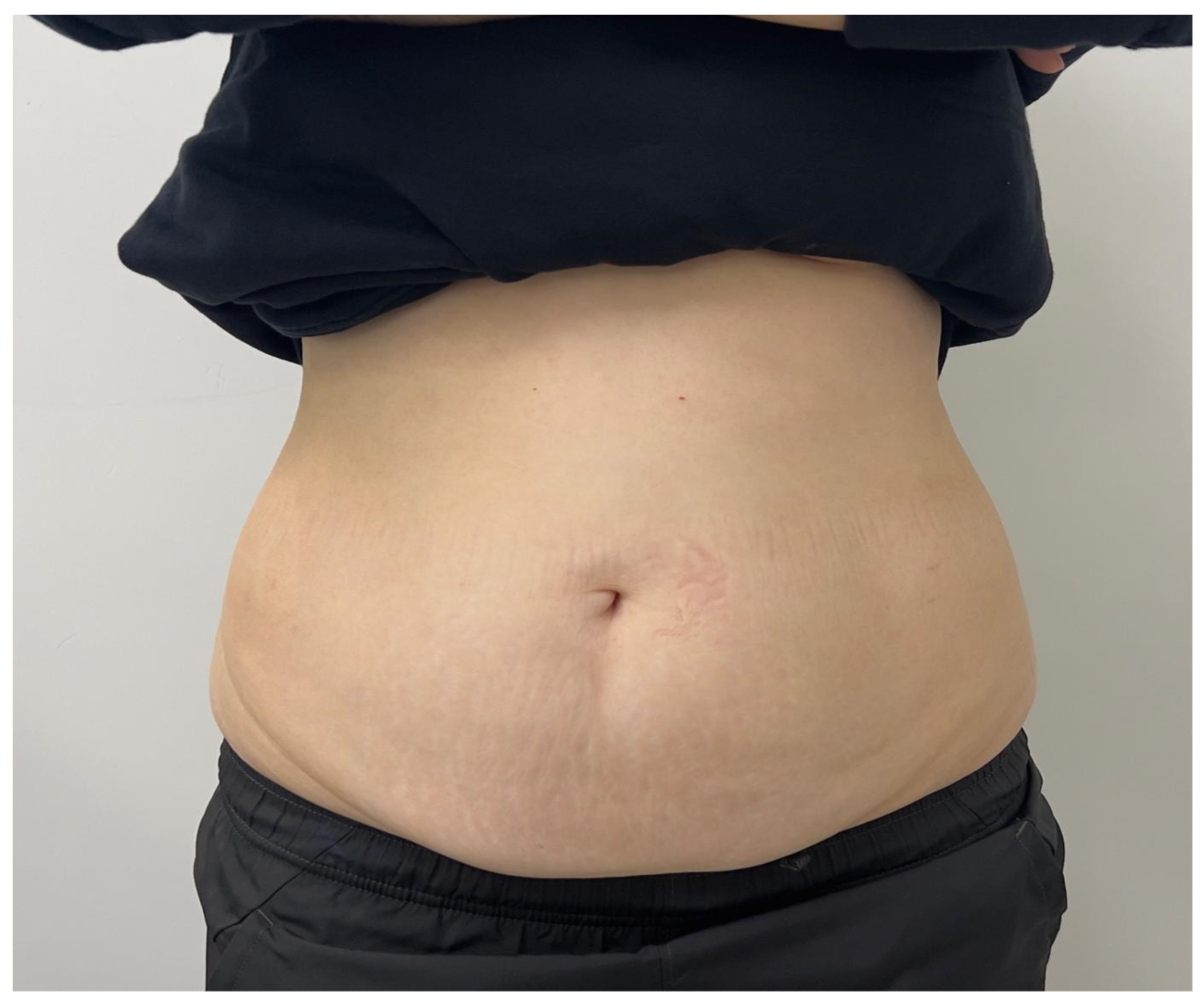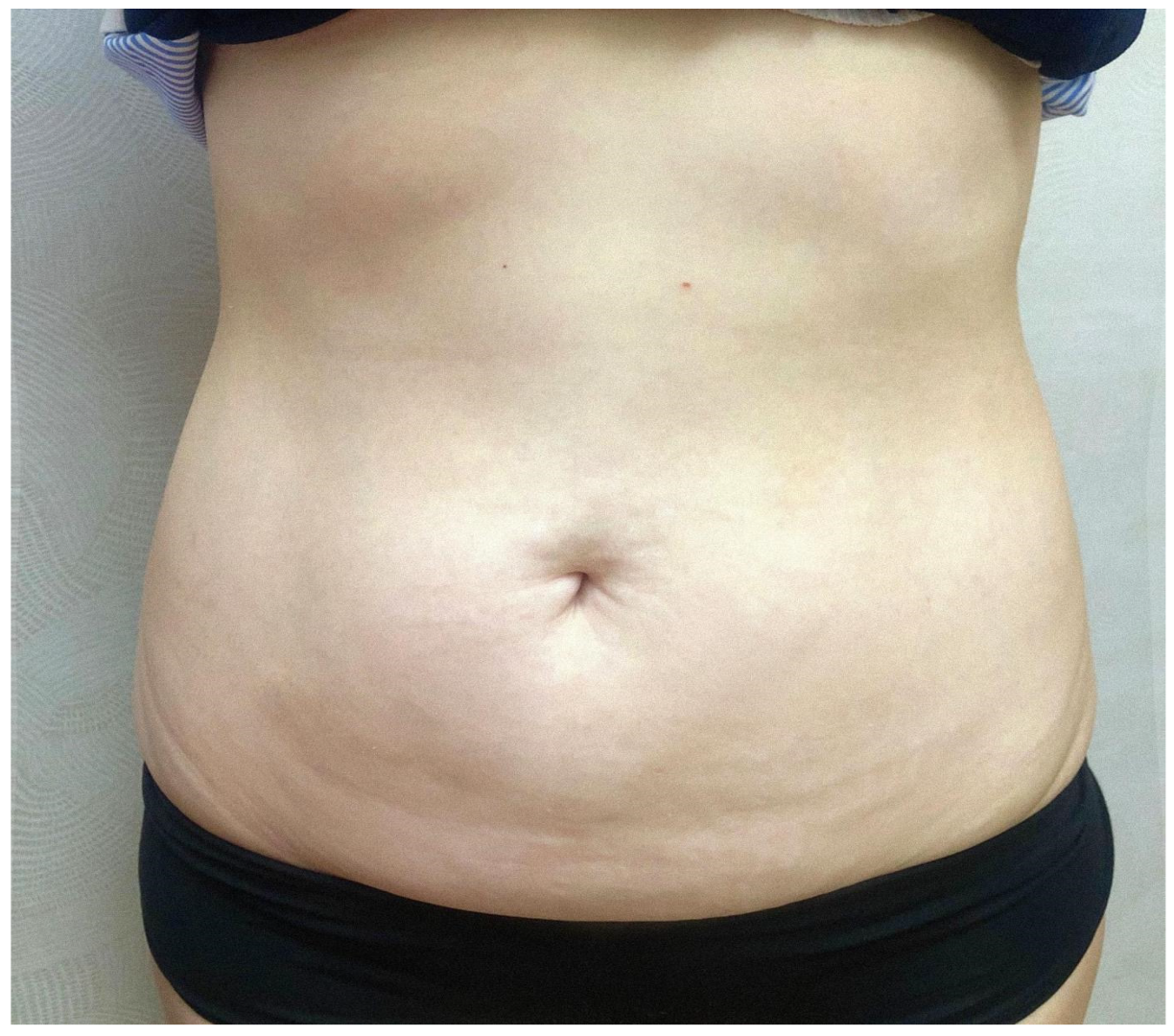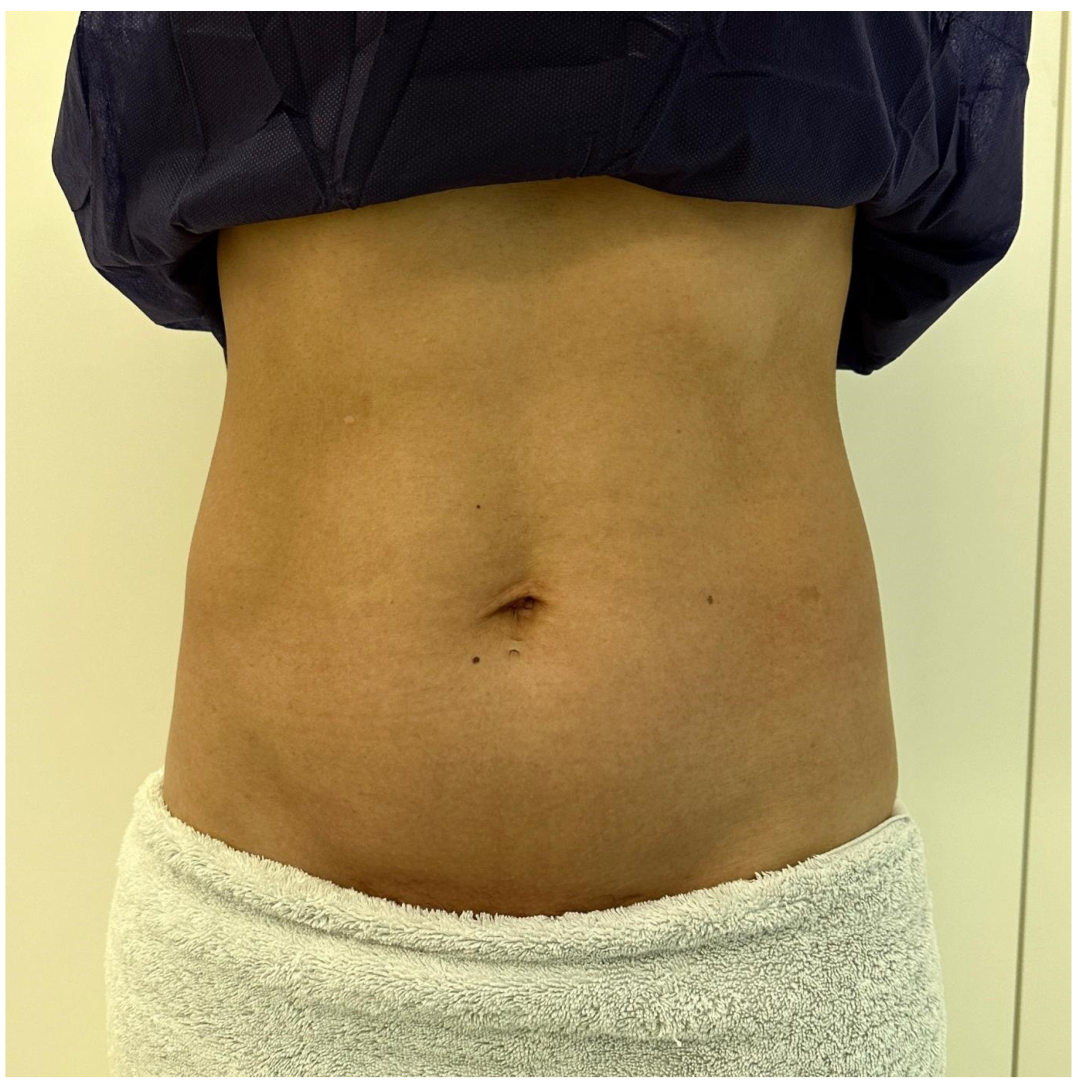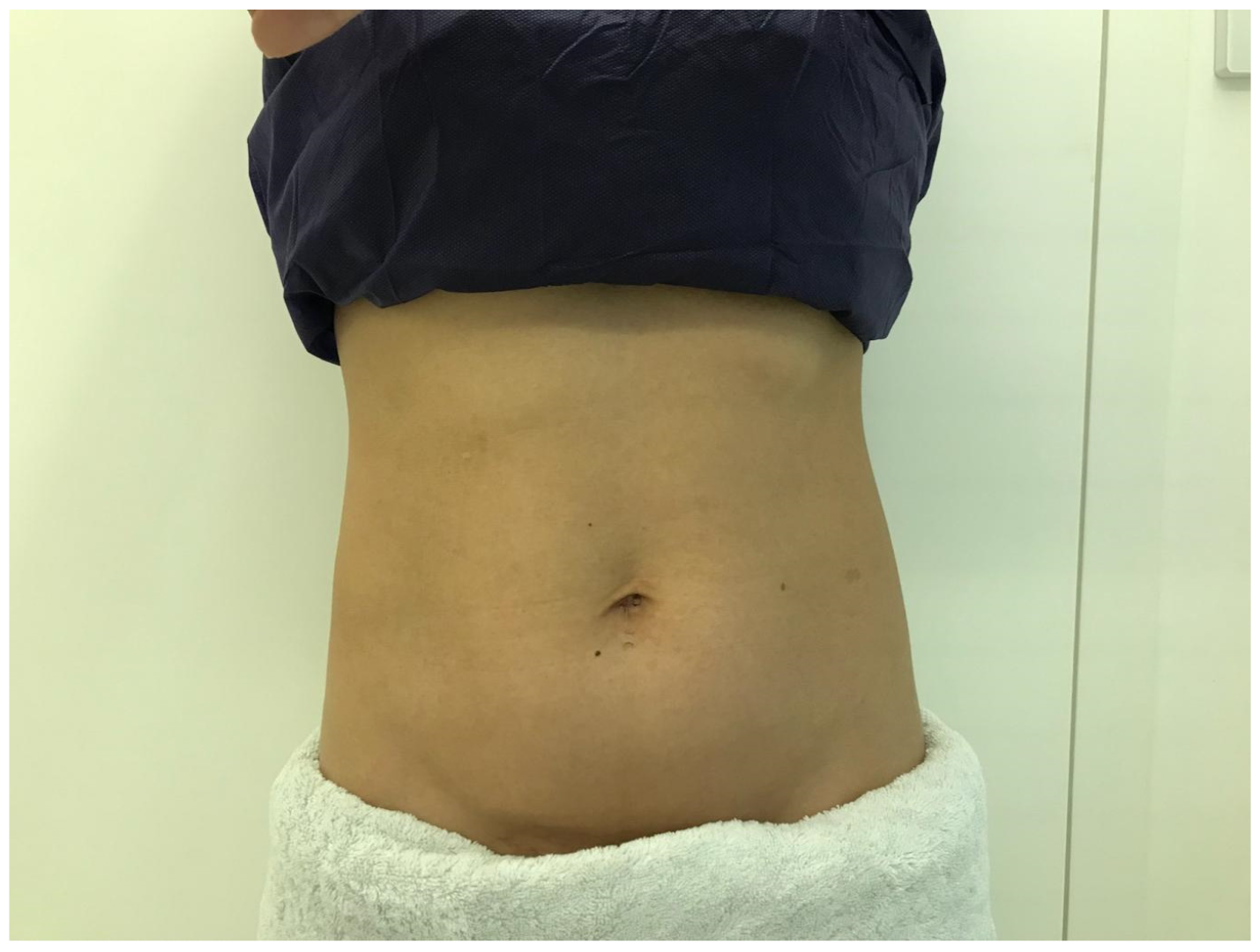Pilot Study of Microfocused Ultrasound, Incobotulinum Toxin, and Calcium Hydroxyapatite in Triple Therapy for Skin Tightening after Weight Loss
Abstract
:1. Introduction
2. Material and Methods
3. Case 1
4. Case 2
5. Case 3


6. Case 4
7. Results
8. Discussion
8.1. Microfocused Ultrasound
8.2. Calcium Hydroxyapatite
8.3. Incobotulinum Toxin A (IncoBTX-A)
8.4. Limitation
9. Conclusions
Author Contributions
Funding
Institutional Review Board Statement
Informed Consent Statement
Data Availability Statement
Conflicts of Interest
References
- Brightman, L.; Weiss, E.; Chapas, A.M.; Karen, J.; Hale, E.; Bernstein, L.; Geronemus, R.G. Improvement in arm and post-partum abdominal and flank subcutaneous fat deposits and skin laxity using a bipolar radiofrequency, infrared, vacuum and mechanical massage device. Lasers Surg. Med. Off. J. Am. Soc. Laser Med. Surg. 2009, 41, 791–798. [Google Scholar] [CrossRef] [PubMed]
- Park, J.Y.; Lin, F.; Suwanchinda, A.; Wanitphakdeedecha, R.; Yu, J.; Lim, T.S.; Chen, J.F.; Ho, W.; Lim, J.; Juniarty, L.; et al. Customized treatment using microfocused ultrasound with visualization for optimized patient outcomes: A review of skin-tightening energy technologies and a pan-Asian adaptation of the expert panel’s gold standard consensus. J. Clin. Aesthetic Dermatol. 2021, 14, E70. [Google Scholar]
- Lapatina, N.G.; Pavlenko, T. Diluted calcium hydroxylapatite for skin tightening of the upper arms and abdomen. J. Drugs Dermatol. 2017, 16, 900–906. [Google Scholar] [PubMed]
- Wu, W.T. Microbotox of the lower face and neck: Evolution of a personal technique and its clinical effects. Plast. Reconstr. Surg. 2015, 136, 92S–100S. [Google Scholar] [CrossRef]
- Brandt, F.S.; Bellman, B. Cosmetic use of botulinum A exotoxin for the aging neck. Dermatol. Surg. 1998, 24, 1232–1234. [Google Scholar] [CrossRef]
- Kaplan, H.; Gat, A. Clinical and histopathological results following TriPollar™ radiofrequency skin treatments. J. Cosmet. Laser Ther. 2009, 11, 78–84. [Google Scholar] [CrossRef] [PubMed]
- Suh, D.-H.; Chang, K.-Y.; Son, H.-C.; Ryu, J.-H.; Lee, S.-J.; Song, K.-Y. Radiofrequency and 585-nm pulsed dye laser treatment of striae distensae: A report of 37 Asian patients. Dermatol. Surg. 2007, 33, 29–34. [Google Scholar] [CrossRef] [PubMed]
- Anolik, R.; Chapas, A.M.; Brightman, L.A.; Geronemus, R.G. Radiofrequency devices for body shaping: A review and study of 12 patients. Semin. Cutan. Med. Surg. 2009, 28, 236–243. [Google Scholar] [CrossRef] [PubMed]
- Kapoor, R.; Shome, D.; Ranjan, A. Use of a novel combined radiofrequency and ultrasound device for lipolysis, skin tightening and cellulite treatment. J. Cosmet. Laser Ther. 2017, 19, 266–274. [Google Scholar] [CrossRef] [PubMed]
- Moreno-Moraga, J.; Muñoz, E.; Navarro, P.C. Multisource, phase-controlled radiofrequency for treatment of skin laxity: Correlation between clinical and in-vivo confocal microscopy results and real-time thermal changes. J. Clin. Aesthetic Dermatol. 2011, 4, 28. [Google Scholar]
- Ko, E.J.; Hong, J.Y.; Kwon, T.R.; Choi, E.J.; Jang, Y.J.; Choi, S.Y.; Yoo, K.H.; Kim, S.Y.; Kim, B.J. Efficacy and safety of non-invasive body tightening with high-intensity focused ultrasound (HIFU). Ski. Res. Technol. 2017, 23, 558–562. [Google Scholar] [CrossRef] [PubMed]
- Laubach, H.J.; Makin, I.R.; Barthe, P.G.; Slayton, M.H.; Manstein, D. Intense focused ultrasound: Evaluation of a new treatment modality for precise microcoagulation within the skin. Dermatol. Surg. 2008, 34, 727–734. [Google Scholar] [CrossRef] [PubMed]
- Voravutinon, N.; Seawthaweesin, K.; Bureethan, A.; Srivipatana, A.; Vejanurug, P. Efficacy of diode laser (810 and 940 nm) for facial skin tightening. J. Cosmet. Dermatol. 2015, 14, E7–E14. [Google Scholar] [CrossRef] [PubMed]
- Yutskovskaya, Y.A.; Sergeeva, A.D.; Kogan, E.A. Combination of Calcium Hydroxylapatite Diluted with Normal Saline and Microfocused Ultrasound with Visualization for Skin Tightening. J. Drugs Dermatol. 2020, 19, 405–411. [Google Scholar] [CrossRef] [PubMed]
- Jabbour, S.F.; Kechichian, E.G.; Awaida, C.J.; Tomb, R.R.; Nasr, M.W. Botulinum toxin for neck rejuvenation: Assessing efficacy and redefining patient selection. Plast. Reconstr. Surg. 2017, 140, 9e–17e. [Google Scholar] [CrossRef] [PubMed]
- Park, J.Y.; Chen, J.F.; Choi, H.; Ho, W.W.; Lesthari, N.N.I.; Lim, J.T.E.; Lim, T.S.; Lowe, S.; Ong-Amoranto, B.; Vachiramon, V.; et al. Insights on skin quality and clinical practice trends in Asia pacific and a practical guide to good skin quality from the inside out. J. Clin. Aesthetic Dermatol. 2022, 15, 10. [Google Scholar]
- Fabi, S.G.; Burgess, C.; Carruthers, A.; Carruthers, J.; Day, D.; Goldie, K.; Kerscher, M.; Nikolis, A.; Pavicic, T.; Rho, N.-K.; et al. Consensus recommendations for combined aesthetic interventions using botulinum toxin, fillers, and microfocused ultrasound in the neck, décolletage, hands, and other areas of the body. Dermatol. Surg. 2016, 42, 1199–1208. [Google Scholar] [CrossRef] [PubMed]
- Ho, W.W.S.; Chan, L.; Corduff, N.; Lau, W.-T.; Martin, M.U.; Tay, C.M.; Wang, S.; Wu, R. Addressing the Real-World Challenges of Immunoresistance to Botulinum Neurotoxin A in Aesthetic Practice: Insights and Recommendations from a Panel Discussion in Hong Kong. Toxins 2023, 15, 456. [Google Scholar] [CrossRef] [PubMed]
- Bartsch, R.; Casabona, G.; Sitzwohl, C.; Kimberger, O.; Green, J.B.; Stanger, J.; Frank, K.; Onishi, E.C.; Cotofana, S. The Influence of Different Treatment Combinations on Skin Laxity and Dimpling. J. Drugs Dermatol. 2020, 19, 1030–1038. [Google Scholar] [CrossRef] [PubMed]
- Duncan, D.I. Combination treatment for buttock and abdominal remodeling and skin improvement using HIFEM procedure and simultaneous delivery of radiofrequency and targeted pressure energy. J. Cosmet. Dermatol. 2021, 20, 3893–3898. [Google Scholar] [CrossRef] [PubMed]







Disclaimer/Publisher’s Note: The statements, opinions and data contained in all publications are solely those of the individual author(s) and contributor(s) and not of MDPI and/or the editor(s). MDPI and/or the editor(s) disclaim responsibility for any injury to people or property resulting from any ideas, methods, instructions or products referred to in the content. |
© 2023 by the authors. Licensee MDPI, Basel, Switzerland. This article is an open access article distributed under the terms and conditions of the Creative Commons Attribution (CC BY) license (https://creativecommons.org/licenses/by/4.0/).
Share and Cite
Chan, L.K.W.; Lee, K.W.A.; Lee, C.H. Pilot Study of Microfocused Ultrasound, Incobotulinum Toxin, and Calcium Hydroxyapatite in Triple Therapy for Skin Tightening after Weight Loss. Cosmetics 2023, 10, 168. https://doi.org/10.3390/cosmetics10060168
Chan LKW, Lee KWA, Lee CH. Pilot Study of Microfocused Ultrasound, Incobotulinum Toxin, and Calcium Hydroxyapatite in Triple Therapy for Skin Tightening after Weight Loss. Cosmetics. 2023; 10(6):168. https://doi.org/10.3390/cosmetics10060168
Chicago/Turabian StyleChan, Lisa Kwin Wah, Kar Wai Alvin Lee, and Cheuk Hung Lee. 2023. "Pilot Study of Microfocused Ultrasound, Incobotulinum Toxin, and Calcium Hydroxyapatite in Triple Therapy for Skin Tightening after Weight Loss" Cosmetics 10, no. 6: 168. https://doi.org/10.3390/cosmetics10060168
APA StyleChan, L. K. W., Lee, K. W. A., & Lee, C. H. (2023). Pilot Study of Microfocused Ultrasound, Incobotulinum Toxin, and Calcium Hydroxyapatite in Triple Therapy for Skin Tightening after Weight Loss. Cosmetics, 10(6), 168. https://doi.org/10.3390/cosmetics10060168





